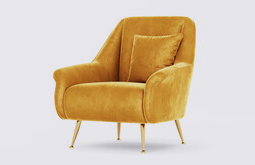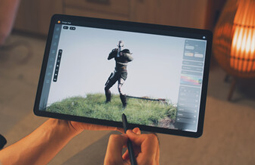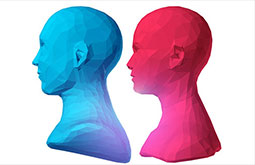Boost Online Sales with 3D eCommerce Product Visualization
Online shopping definitely has its advantages, convenience, and charm. However, probably one of the biggest challenges that still dominate this sector is the difficulty of perceiving a product on an eCommerce platform. Doubts regarding the actual size, fitment, color, and model - are reasons why most people still prefer going the traditional way.
To bridge this visible gap between physical and digital, eCommerce marketers are striving to find more effective ways of showcasing their products with clarity. In short, they are leveraging 3D technology to display products from a 3D perspective. This is exactly what 3D product visualization stands for.

This unique approach not only helps prospects get a clear idea of the product but also shortens their decision-making process. So, if you are a product seller and own an eCommerce store, read this blog till the end. This article discusses in detail how to outline your products on listing platforms and enhance them with 3D visualization.
Learn what 3D product visualization is and gain insights into the impact these immersive visuals have on customers, turning them into repeat clients.
10 easy ways to boost online sales for 3D Product Visualization
Implementing 3D product visuals might seem complex, but in reality, it is quite simple. Beginner online sellers with no prior experience in 3D technology can also dive into it and turn their businesses towards profit. Nothing pays off more than letting customers see and feel product demos beyond 2D images.
There are several experienced 3D design service providers who offer outstanding product 3D modeling and rendering services. These professional agencies have years of experience and offer tailored 3D visualization services for online businesses.
Check out the best ways one can harness 3D designs and visuals for their product listings, aiding their business growth and boosting revenue.
-
3D product viewers
Interactive 3D product viewers make the shopping experience even more engaging for prospects. The technology helps e-tailers showcase products in an engaging and memorable way. Be it fashion garments, accessories, electronic appliances, or home furnishing items, everything can be viewed from multiple angles.
With a product viewer implemented within its virtual store, a brand can empower visitors to see the product with better clarity. Eventually, this product clarity inspires them to buy the item with confidence.
-
Virtual try-ons
The 3D virtual try-on technology is powered by Augmented Reality (AR). When a prospect selects a product, be it eye gears, watches, sunglasses, jewelries, etc., the technology creates an overlay of the item on their face.
Replicating the in-store shopping experience, this unique trying-on feature enables customers to try the items before buying, albeit virtually. This leads to fewer returns and more customer satisfaction.
-
3D configurators
Being in control of what the final product will look like immensely influences customers’ purchase decisions nowadays. 3D product configurators give them power and control over the final appearance of the product they are about to buy.
Whether it is a cushion cover, an outfit, a table, a sofa, furnishing stuff, or luxury home lighting items - everything can be personalized to the buyers’ tastes. This is a fascinatingly innovative solution that leads to more informed purchase decisions and, as a result, greater sales.
-
CGI-based immersive experiences
One step up from virtual try-ons (discussed above) and product configurators or changers (discussed above), CGI-based images are the latest trends. If you own a quirky pop-culture-themed apparel brand, let your customers create their virtual ‘avatars’ and see how the apparel looks on their characters.
This is also a great marketing tactic geared towards gaming enthusiasts. Gamers love to see themselves in the appearance of their favorite game characters while decked in similar outfits. Implementing this out-of-the-box technology within your online store can give you higher profits.
-
360° spin imagery
Do you have a furniture store? Or are you a furniture manufacturer? Regardless of your business model, help your customers evaluate products in a more data-driven manner. 360-degree images or visuals let buyers view the products from multiple angles and even get cross-sectional views.
This technology is ideal for furniture retailers since buying furniture items online is still a major dilemma for consumers. 360° product spins completely ease this doubt, increase the time spent on the webpage, enhance the overall buying experience, and, lastly, minimize product returns.
-
CGI product demos
This is another method of harnessing the boundless potential of 3D images. With a well-made CGI demo, you can not only showcase the product in use but also highlight its key USPs and features. This is a fantastic way of letting clients see how the product functions.
The demos showcase the intricacies of the product, making it easy-to-understand for the buyers. Such 3D demos also build trust among the target audience, testifying about the brand’s professionalism and tech-savvy nature.
-
AR-based product placement
Much like the virtual try-ons (discussed above), AR-based contextual positioning technology is another great way of boosting online sales. Innovative 3D product designs that are placed in the real-world setting of the buyer help them visualize how the products look in their space.
By scanning the QR codes on the product through smartphones, customers can see how a table lamp looks on their bedside table or how an antique flower vase complements their living room. If you have 3D models ready, you can right away integrate AR functionality into your online store.
-
Hyper-realistic lifestyle 3D renders
3D rendering is not just the final stage of the 3D design process but is also a highly engaging visualization technique. In the rendering stage, the 3D artist generates 2D images from 3D models using high-end software.
These 3D rendering software are specially made for the purpose and extracts data from the digital models. One such stylistic product presentation is the lifestyle rendering. In this, the digital twins of the products are featured against various lifestyle settings. This is ideal for developing top-grade marketing materials.
The products are showcased with unbelievable realism and create an aesthetic appeal. The best part of product lifestyle images is that one can create multiple looks in different lifestyle settings using the same product.
-
3D animated product videos
3D product animations or videos capture the audience’s attention like nothing else. These animated video contents feature real-life scenarios, making a product believable and usable in practical life. One can create a specific marketing narrative with these videos, showcasing immersive product visuals.
3D animated product videos also have the capacity to increase outreach as well as boost likes and shares on social media. The more detailed the products appear, the higher the chances of conversion. To get a professionally developed product with 3D animation, make sure you hire the right agency.
-
3D virtual trial room
In the recent past, there’s a growing number of online apparel brands and eCommerce platforms where everything is under the same roof. As a result, more and more consumers are leaning towards online shopping, especially for apparel and dresses.
Now, the biggest hassle for consumers while buying a jeans, a top, a T-shirt, a blazer, a one-piece, or anything similar is the'size' factor. Although the sites do have size charts, more often than not, buyers get faulty sizes. This leaves them dissatisfied and discouraged.
But fret not. Embed a 3D virtual trial room feature in your online store and let buyers see the fittings of their selected dresses. The technology works on AR and allows buyers to view a digital mannequin of their shape and size. They can mention their body types and get the exact size. The size details are then analyzed, and a tailored dress is created for that specific order placement.
Since, in the fashion industry, there’s no ‘one-size-fits-all’ concept, it is mandatory for clothing brands to have this feature in their eCommerce stores.
Leading eCommerce brands leveraging product 3D visualization perfectly
Currently, several big brands are implementing 3D product visuals to create long-lasting impressions on their customers. Starting from smaller brands to the bigger game players, everywhere we can see the influence of 3D technology-driven assets.
Let us quickly glance through some of these brands, successfully enjoying the numerous benefits of 3D technology.
-
IKEA
IKEA, the Swedish conglomerate of ready-to-assemble furniture, is one of the earliest adopters of AR technology, having introduced its indigenous app, IKEA Place. Customers could scan the item QR codes and contextually place the products within their room settings.
These 3D models are true-to-scale and give an exact preview of how the item complements their homes.
-
Adidas
The international German athletic footwear and apparel manufacturer is also a big enthusiast of 3D AR-based product experiences. As a part of its product promotional activity, Adidas launched an iOS app, to empower its target audience and buyers to make better-informed purchases.
Users of the app could see how a pair of shoes or sneakers looks on their feet while they run or walk.
-
Herman Miller
This American company, which excels in ergonomic and lightweight furniture, adapted a 3D product configurator. This feature enables buyers to personalize each item according to their tastes and preferences.
The feature gives a virtual showroom-like feel, wherein interested prospects could see multiple variations of a furniture piece before freezing on one.
-
L’Oréal
This France-based personal care company, one of the world leaders in beauty products, bridged the gap between physical and digital buying. This happened when L’Oréal first acquired ModiFace, an AR development company, then later teamed up with Facebook and introduced a unique feature.
This feature lets consumers try out cosmetic shades as well as give them tailored suggestions. The AR technology analyzed the skin type and tone of each prospect and suggested the ideal foundation/compact shade, lipstick color, eyeliner, and mascara that complement the user’s personality.
-
Levi’s
Levi’s launched in-store customization back in 2015 and gradually evolved into offering detailed customization online. Interested buyers can design their own pair of jeans, sweatshirts, t-shirts, cargo pants, shorts, jackets, and everything else online.
Consumers can customize based on pattern, color, overdye, fabric, style, distressed, washed-out and ripped effects. All of these modifications must be made through Levi’s 3D catalog.
Conclusion
So, you see, harnessing the unbounded potential of 3D technology, AR, and product visualization for eCommerce is the best thing one can do in the current times. Perhaps the transition will take time. But with the right kind of resources and expert guidance available, the eCommerce industry can develop more customer-centric solutions.
So, if you wondered why online stores need 3D designs for their products, we believe this article gave you the answers with adequate insights on the following:
- 3D product visualization
- How the technology works
- Ways to leverage its possibilities to boost sales, and finally,
- Top global brands that are doing the same
From fashion, furniture, and real estate to healthcare, footwear, and manufacturing - 3D design will continue to hold influence. Find professional 3D product visualization agencies and get the best 3D design services at an affordable cost with a fast turnaround. Leverage 3D product visualization to scale up your eCommerce in future and beyond!




